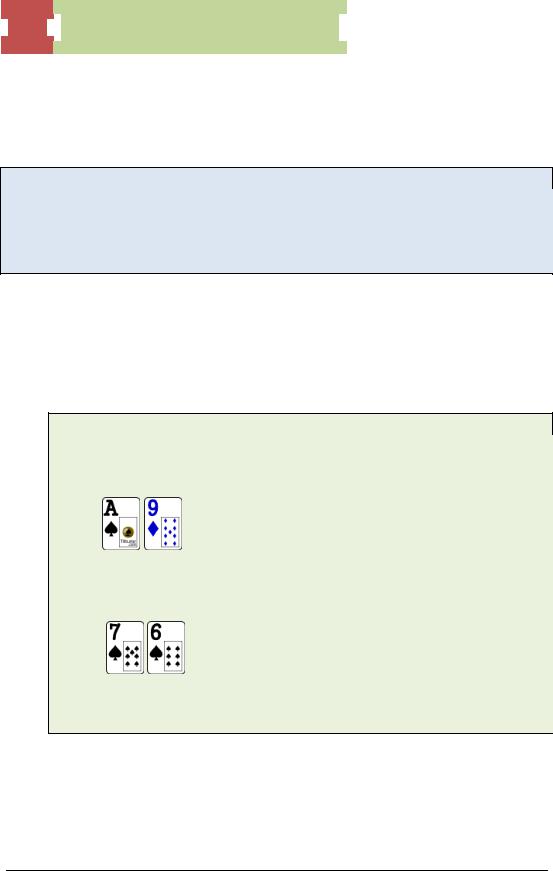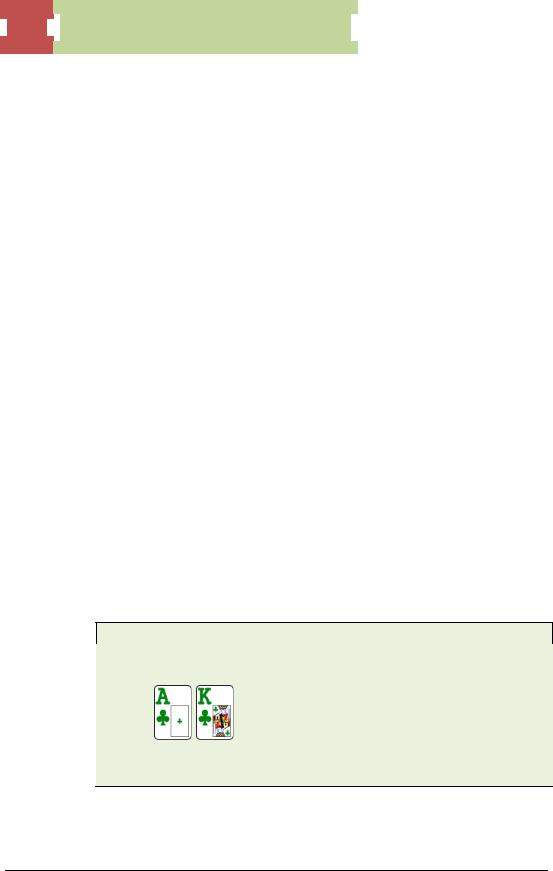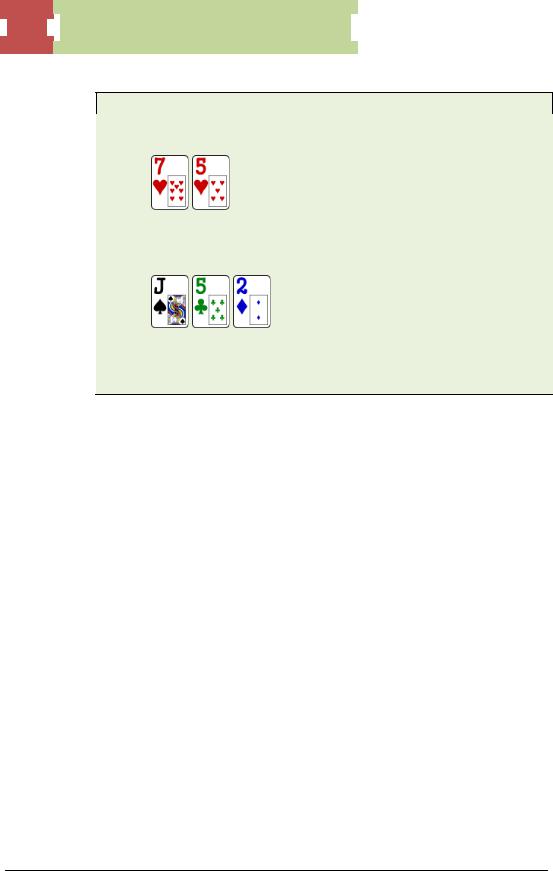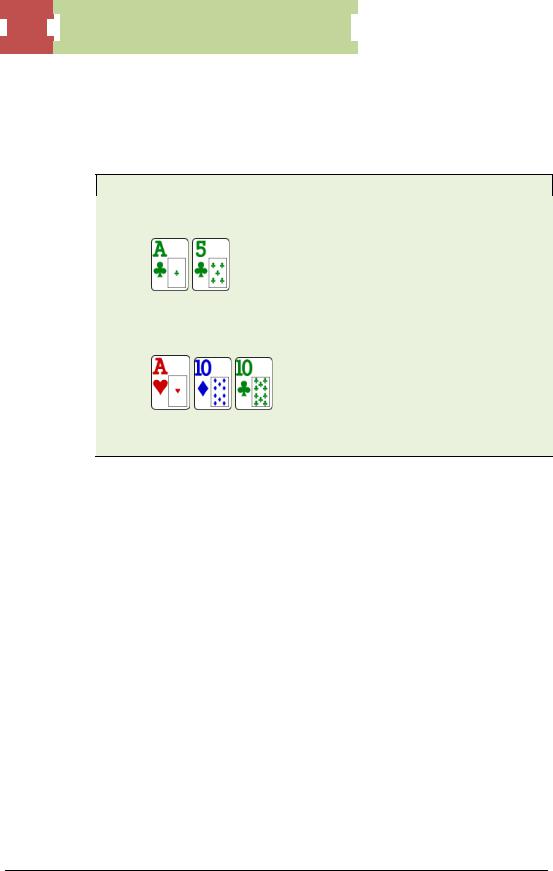
Davis, Aron. The Poker Blueprint
.pdf
 59
59  Preflop: The Fundamentals
Preflop: The Fundamentals
Hand Ranges
A good hand player can profitably play 50% of his hands from the button. Those who prefer playing a tighter style play from 30% to 35%. A range of 35% includes: all pocket pairs, Axs, K2s+, Q2s+, J7s+, T7s+, 96s+,86s+,76s,65s, A8o+, K9o+, Q9o+, J9o+, T9o.
Deciding which hands to play will depend on whether it is folded to you and how good the players are in the blinds. If the blinds are fishy, then I would widen my range. If the players in the blinds are aggressive and like to 3-bet, then I would fold hands such as 33, J9o or 75o that can’t profitably call re-raises. If the players in the blinds are good at playing post-flop and give me trouble, then I would fold the majority of my low suited connectors and non-broadway two-gappers as well. Keep in mind that you want to be raising with the majority of the speculative hands on the button, not calling. It is not profitable to call raises with KTo, A4o, or 75s. Those hands are tough to play without the initiative.
Limping Behind
You should generally raise pre-flop if there’s only one limper. When there are two or more limpers, I would limp behind with weaker hands such as Axs and suited connectors that play well in multi-way pots. With Axs, you will be able to cooler more players when you both flop a flush draw. T7s and 65s are also great because your hands can make some kind of a straight. Avoid calling with J5s type hands. With 99+, AK, KQ, or KJs, you should raise pre-flop regardless of how many limpers there are.
Another play I often like to use is open limp on the button or to min-raise the button if it is folded to me. I do this when a player in the blinds is bad but is overly aggressive preflop. I don’t want to bloat the pot pre-flop because that will decrease the stack-to-pot ratio and make it easier for him to play against me. When playing against a very aggressive opponent, I want to put in the minimal amount of money before we see a flop. Since he is so aggressive, I can take advantage of it by committing more chips when I make a strong hand post-flop.
Loose/Tight Limpers
Against players who never limp-fold or check-fold on the flop, tighten up your raising range. Your main purpose for isolating is to take down the pot right away. In loose games where there are always three or four people in a pot, it’s best to really cut down on your isolation, especially with middle offsuit connectors like T9o. I would fold these speculative hands.
© 2010 Aaron Davis and Tri Nguyen - All Rights Reserved.
http://www.DailyVariance.com
59

 60
60  Preflop: The Fundamentals
Preflop: The Fundamentals
Against players who limp-fold or check-fold the flop a lot, you should raise with hands that you decide to play with. It’s also preferable to isolate with Q8s more than 65s in this case, because you will make stronger one-pair hands, straights, and flushes.
Important Note: Many small-stakes players often make the mistake of raising with 65s against an opponent who never limp-folds. Or they open with speculative hands when a player on the blinds likes to 3-bet light. I know I used to burn money not realizing this because it is such a small mistake. However, if you do keep committing the same small mistake over and over again, it will get costly in the future.
Stack Sizes
With several short-stackers at your table, high card hands such as KTo or A9o go up in value because you can flop a strong pair. Against full stacks, their values diminish and suited connectors like 76s are better due to better implied odds and drawing potentials. Let me demonstrate.
100 NL – 6 max. Shortstacks in the blinds.
Everyone folds to you and both blinds have $35. You’ll want to raise with hands like
Your goal is to flop a pair and get it in on a safe board. But if they have +$100, suited connectors like
are better to raise with because these types of hand play well when stacks are full or deep. Your hand is deceptive and can extract a lot of value post-flop.
The deeper you are, the more hands you want to play from the button. It is very tough for your opponent to play against you because he has to play 4 streets of poker and on each street, he has to worry about the next one where the bet size could potentially get bigger. With 100BBs, your opponent decreases his positional disadvantage by bloating the pot pre-flop and can get his stack in by the turn. With 200BBs, bloating the pot pre-flop is not
© 2010 Aaron Davis and Tri Nguyen - All Rights Reserved.
http://www.DailyVariance.com
60

 61
61  Preflop: The Fundamentals
Preflop: The Fundamentals
as attractive anymore because I can call with more hands pre-flop and try to put pressure on him post-flop.
3-betting
Your 3-betting range from the button should be the widest out of all the positions. The main reason is you have position. My approach for 3-betting on the button depends more on who my opponent is rather than the strength of my hand. If my opponent keeps folding to 3-bets, then I would 3-bet him all day. If my opponent does call 3-bets but check-fold whenever he misses the flop, then I would 3-bet him all day as well. Of course, I wouldn’t go out of my way to 3-bet with bad hands such as 74o or J7o.
When 3-betting from the button, be conscious of players in the blinds. If they don’t get out of line often by 4-betting you light, then you should 3-bet as often as you can. However, once you recognize that players on the blinds is 4-betting you light, you should decrease your 3-betting frequency. I don’t think you should worry too much about this concept since it rarely happen in games below 200nl. However, it is good for you to know you to know of such an idea so you can take advantage of the situation when it arises.
Important Note: Keep in mind is there are times when you should deliberately force yourself to fold pre-flop sometimes. The main reason is you don’t want an opponent who’s been folding too much to recognize that he’s folding too much. You want to give him the illusion that he’s not constantly getting exploited even though he is.
Stealing the Blinds
If everyone folds to you on the button, then you should keep stealing the blinds until the players fight back. Most regulars play very tight from the blinds and some will fold to your steals almost 90 percent of the time. That’s 9 out of 10 times.
Some players will call from the blinds but they will check-fold often that raising pre-flop and c-betting a lot is profitable. Sometimes, I would raise pre-flop and intentionally give up when I have no equity in the pot. The main reason is I want to show whoever that is defending the blinds that I’m not trying to steal every single pot. This makes my life easier because they are going to give me credit for a hand when I bet and more importantly, they are less inclined to fight back.
© 2010 Aaron Davis and Tri Nguyen - All Rights Reserved.
http://www.DailyVariance.com
61

 62
62  Postflop: Time to Play Poker
Postflop: Time to Play Poker
Postflop: Time to Play Poker
© 2010 Aaron Davis and Tri Nguyen - All Rights Reserved.
http://www.DailyVariance.com
62

 63
63  Postflop: Time to Play Poker
Postflop: Time to Play Poker
Why We Bet
It’s never a good idea to bet without a reason. You always want to know why you’re making a certain play in every situation, and betting is no exception. You should make betting decisions based on your perception of being ahead or behind your opponent’s range.
1.When you have the best hand, you usually want to bet for value and extract money. You also do it to protect your hand and prevent your opponents from drawing out on you. It is important to note that there are times when you know you have the best hand but should check instead of betting. This is because no worse hand is calling and no better hand is folding. For example, you have QQ on J39KA. You will often have the best hand on the river. However, unless there is some history, you should check frequently in this spot.
2.When you rarely have the best hand, you want to bluff Villain off his hand. If called, you have no outs. For example, you have 9To on AK3r. Another type of bluff is the semi-bluff—where you bluff to fold out better hands and still have outs when called. For example, JT on AK3r.
3.Dead money is the money in the pot. This category applies to both of the above situations. You can value-shove the flop with an overpair to take down all the dead money in a 4-bet pot. You can also shove a strong draw in a 4-bet pot. The dead money does not belong to anyone at the table, even if you’ve already put money in. Your goal is to take down as much dead money as you can without getting to showdown, unless, of course, you have the nuts. Below is a simple preflop example.
100 NL – 6 max. 100BB effective stacks.
You open raise to $4 from UTG with
The BTN 3-bets to $14 and you 4-bet all in.
Villain is now forced to fold hands like AQs, KQs, 87s and 76s, and they have about 33-percent equity against AK. You take down the dead money in the middle
© 2010 Aaron Davis and Tri Nguyen - All Rights Reserved.
http://www.DailyVariance.com
63

 64
64  Postflop: Time to Play Poker
Postflop: Time to Play Poker
without having to see the flop. The main objective of playing AK aggressively preflop is to take down the dead money.
© 2010 Aaron Davis and Tri Nguyen - All Rights Reserved.
http://www.DailyVariance.com
64

 65
65  Postflop: Time to Play Poker
Postflop: Time to Play Poker
Continuation Bet
A continuation bet, or c-bet, is when the pre-flop raiser makes a bet on the flop. A wellbalanced c-betting range is a crucial element in the overall development of your game.
Do not make the mistake of blindly c-betting just because Villain checks to you. Make sure you know why you are c-betting. As a general rule, c-betting too much is a mistake, as it will encourage your opponent to check-raise you or call you down more often because he thinks you’re bluffing. That’s not the type of opponent you want to play heads-up against. You want him to be as passive as possible. However, that doesn’t mean c-betting too much is “bad”. Against the right opponents (those who check-fold when they don’t have a hand and show aggression when they do), c-betting can be highly profitable. Below are guidelines on whether you should bet on certain boards.
1.Fold-to-Continuation-Bet Frequency: If you have Hold’Em Manager, there is an option to show how often a player folds to continuation bets. If it’s greater than 70 percent, you can bet your entire range and still profit.
2.Equity: You want to have some sort of equity in the hand. Even with A6 on T54 rainbow, you can still make a pair or a backdoor straight to win the hand some percentage of the time. On 765 rainbow with A3s, you may want to check-fold or check behind.
3.Dry Flop with One High Card: Prime examples are A65r, K83r, QT2r, J73r, T22r. Betting on A- and K-high boards works much better than on other boards because it hits your perceived pre-flop raising range. If your opponents are behind, they usually have five outs or less. You will get lots of folds, so you should bet with almost your entire range here. Furthermore, most of your opponent’s range consists of lower pairs and suited connecters rather than Ax or Kx.
4.Wet Boards: If the flop is T98s and you have AQo, don’t bet. The flop hits a lot of Villain’s medium-hand range and he will call or raise often. Additionally, he usually has a pair to go with a straight draw and you will need three bullets to get him to fold. You also have some equity in the pot that you want to realize.
5.Paired Flops: Avoid betting 552 rainbow with weak hands like 86s or 76s because you have very little equity if he calls. You can check behind and make a delayed c- bet on the turn if he checks again. Your line is congruent to a pocket pair that is
© 2010 Aaron Davis and Tri Nguyen - All Rights Reserved.
http://www.DailyVariance.com
65

 66
66  Postflop: Time to Play Poker
Postflop: Time to Play Poker
playing for pot control or a hand that improves with the turn card. If I bet the turn and get called, I’m done with the hand unless I improve.
With AJ+ on this board, you can check-call as the pre-flop raiser against passive opponents. If he bets again on the turn, you can fold, but most will just check behind. I wouldn’t check-call the flop against aggressive opponents. They will recognize that you have a weak range the majority of the time and will put a lot of pressure on you. Against them, c-betting is better. If they call a lot, consider betting again on the turn, or check-fold the flop if you don’t feel comfortable firing the turn and river as a bluff.
6.Way Behind/Way Ahead: An example of this is KK on A82 rainbow. You’re way behind a pair of Aces, sets and two pair, and you’re way ahead of bottomand middle-pair and random gutshots. You can check behind here sometimes if it is checked to you. You’ll rarely be outdrawn, and since your hand looks like a weak Ax, Villain isn’t going to try to bluff you off it on the turn or river.
7.Multi-Way Pots: You generally want to bet more in a three-way pot on a dry flop because people are less likely to mess around in these spots. But check behind if there’s a short stack.
8.In Position/Out of Position: You should c-bet a lot more often OOP. In position, you can check behind and get a free card. It’s a lot harder to get a free card when you’re OOP, and you generally want to be aggressive to take down the dead money. If you’re playing against a weaker player who will call c-bets a lot but won’t bet it himself when checked to, then you can also check more often to try to get to showdown with a marginal holding.
9.Against Loose Players: You generally want to check behind or check-fold some of the time on low-medium boards (876s, 764s, 542 rainbow, etc.). Loose players like to call flop bets will all sorts of hands, making c-betting on the flop with random hands less profitable to you. You still want to bet every dry ace or king flop against them.
10.Against TAGs: You want to c-bet all the dry boards versus TAGs, and check behind wet boards if you miss. Be prepared to adjust if you suspect they’re attacking you light. Here’s a quick example.
© 2010 Aaron Davis and Tri Nguyen - All Rights Reserved.
http://www.DailyVariance.com
66

 67
67  Postflop: Time to Play Poker
Postflop: Time to Play Poker
100 NL – 6 max. 100BB effective stacks.
Say you open-raise to $4 from the CO with
BB calls and the flop is
Villain checks and you c-bet 2/3 of the pot. He check-raises to three times your bet size.
You can’t really fold here because he’s representing a narrow value range and you have a good enough hand to continue, especially with the overlay in the pot and the chance that your hand is likely best once improved.
For his range, his raise makes little sense unless he slow-played an overpair. JJ, 55, and 22 would check-call the majority of the time. There’s only one combination of
55, and 22 is unlikely because most TAGs fold small pocket pairs against lateposition openers. That leaves us with AJ and QQ+, hands that would re-raise preflop. Knowing that, you can call here or even throw in a small 3-bet to end the hand now (fold to a 4-bet). If you call the flop and he bets again on the turn, you can fold. Although this line seems exploitable, your opponent isn’t exploiting you as often as you think since your calling range on this flop is pretty strong. However, you should be conscious of how often you can flop bets and fold to turn bets all the time. If you do this a lot, you are burning money and you should question if you are getting bluffed on the turn a lot.
11.Inducing Bluffs: Some players will almost always bet the flop or the turn once you check the flop. They will consider that as weakness, and rightfully so. You can check-call with AT+ on A83 rainbow because you have the majority of hands beat and you will rarely be outdrawn. If there’s a flush draw possible on the board, you should bet to charge his draw and to make the hand a little easier to play.
© 2010 Aaron Davis and Tri Nguyen - All Rights Reserved.
http://www.DailyVariance.com
67

 68
68  Postflop: Time to Play Poker
Postflop: Time to Play Poker
12.Polarizing your range: You’ll want to polarize your range when you check behind. This means you bet the flop with strong hands and air, but check behind with marginal hands.
100 NL – 6 max. 100BB effective stacks.
Say you open-raise to $3 from the button with
and the SB calls. The flop is
SB checks. Just check behind.
If SB has an ace, his kicker is likely higher than yours. The best-case scenario sees you chop at the river. So you check back here to keep the pot small because he’s rarely going to call the flop with a hand you beat. If he leads the turn, you can call. If he checks again, you can check behind again and maybe go for a small value bet on the river. If he’s not capable of calling you with a hand like JJ on the river, then you should just check behind. Although this may seem exploitable, many players at micro-stakes and even small stakes will not realize that you’re using this strategy.
An interesting scenario is when the board is A22r instead. You should bet with A5 in this spot because pocket pairs are more likely to call. On ATTr if you have a small pocket pair like 55, you will face hands such as KQ, QJ, and KJ that are behind but have great equity against you. For this reason, you should lean toward betting.
© 2010 Aaron Davis and Tri Nguyen - All Rights Reserved.
http://www.DailyVariance.com
68
